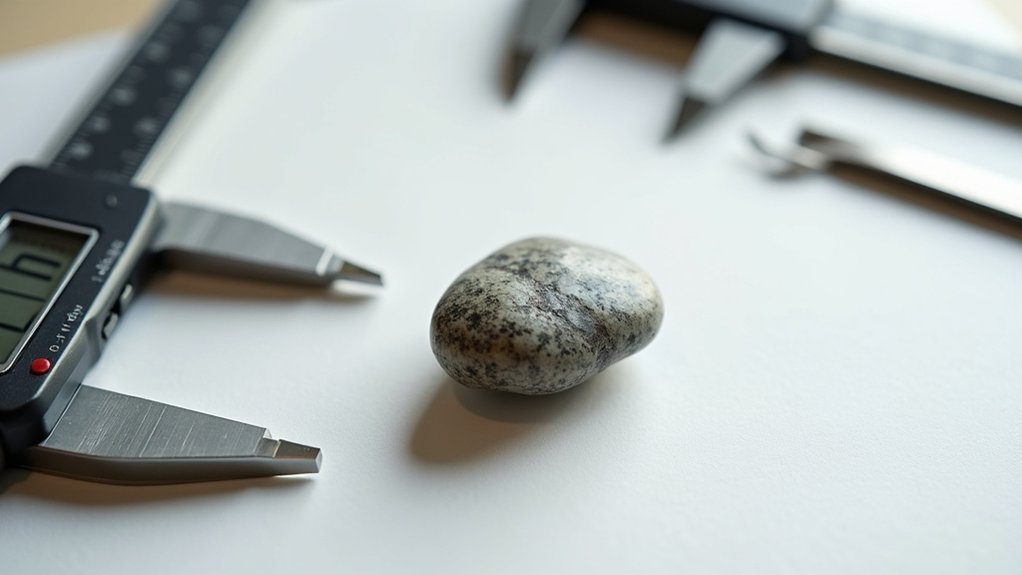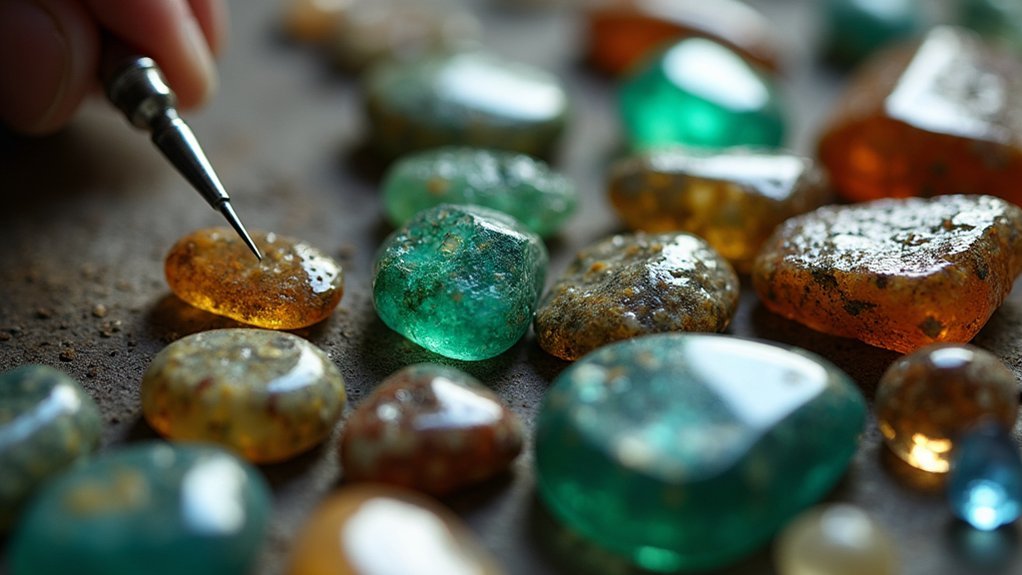You’ll succeed with irregular stone bezeling by measuring accurately with calipers and creating cardstock templates first. Choose fine silver strips for complex shapes due to their superior malleability, or consider argentium wire for seamless fusion. Master tension control by starting with loose initial rounds, then gradually tightening at the base while keeping upper sections flexible. Use strategic bead placement around curves and finish with professional cinching techniques from base upward. These foundational strategies will reveal advanced bezeling mastery.
Measure Your Stone Accurately Before Starting

Precision forms the foundation of successful bezel setting for irregular stones. You’ll need calipers or a ruler to capture accurate measurements of your irregular stone’s length and width. Take multiple measurements from different angles since asymmetry can affect your bezel setting’s success.
Accurate measurements from multiple angles ensure your bezel setting accommodates every unique curve and asymmetrical feature of irregular stones.
Don’t forget the height of the stone – measure from base to peak to determine proper bezel wall height.
Sketch the outline on paper, capturing those unique curves and edges that make your stone special. This visualization helps you plan the bezel construction.
Always verify measurements against your stone before cutting materials. Even slight discrepancies can ruin the final setting, preventing that vital snug fit. Double-checking guarantees your bezel will secure the stone effectively.
Choose the Right Bezel Material for Irregular Shapes
When working with irregular stones, you’ll need bezel materials that can adapt to unique curves and angles without cracking or losing their structural integrity.
Fine silver strip offers exceptional malleability for complex shapes, while Argentium wire provides superior weldability and strength for your setting construction.
You’ll also want to evaluate flexible alternatives like copper when dealing with extremely challenging stone contours that demand maximum adaptability.
Fine Silver Strip Benefits
Fine silver strips offer exceptional advantages when creating bezels for irregular stones, delivering both superior workability and long-lasting beauty.
Their malleable nature allows you to shape them precisely around uneven stone edges, ensuring perfect contact and professional results. The high purity content means you’ll reduce tarnishing considerably compared to other metals.
Here are three key benefits:
- Superior Workability – Fine silver strips can be soldered at lower temperatures, protecting delicate stones during assembly.
- Enhanced Durability – Without copper content, your bezel settings remain durable and secure over time.
- Design Flexibility – Multiple thickness options provide versatility in design for stones of varying heights.
You’ll find fine silver strips accommodate irregular stones better than traditional materials, creating secure, attractive settings.
Argentium Wire Advantages
Although traditional sterling silver has long been the standard for jewelry making, Argentium wire offers distinct advantages that make it particularly well-suited for bezeling irregular stones.
You’ll appreciate its germanium content, which provides superior tarnish resistance compared to standard sterling silver. The lower melting point makes soldering and manipulation easier when creating custom bezels for uniquely shaped stones.
Argentium’s ability to fuse without solder creates seamless bezels around irregular stones, delivering cleaner finishes while protecting delicate gems.
Its exceptional workability allows you to shape intricate designs that accommodate unique contours perfectly. The higher silver content produces a brighter, whiter appearance that enhances visual appeal.
This flexibility empowers you to create truly bespoke jewelry pieces that showcase each stone’s individual character.
Flexible Material Options
Since irregular stones present unique challenges that demand adaptable solutions, you’ll need to select bezel materials that can conform to unconventional shapes without compromising structural integrity.
When bezel setting irregular stones, your material choice directly impacts both workability and final appearance.
Consider these flexible material options for unique stone shapes:
- Fine silver – Offers exceptional malleability, allowing easy shaping around complex contours and multiple adjustments during fitting.
- Argentium silver – Provides superior tarnish resistance while maintaining excellent soldering properties for durable bezel settings.
- Copper and brass – Deliver enhanced flexibility and distinctive aesthetic appeal, plus cost-effective experimentation opportunities.
For larger stones with heavy textures, thicker bezel wire provides essential structural support.
Always prioritize adjustable bezel materials that accommodate the iterative fitting process irregular stones require.
Create Custom Templates for Asymmetrical Stones
When you’re working with asymmetrical stones, you’ll need reliable methods to capture their unique contours for precise bezel construction.
You can use the paper pattern method to trace directly onto cardstock, or employ the wire template technique for stones with complex three-dimensional curves.
Both approaches let you create accurate guides that’ll guarantee your bezel fits perfectly around even the most irregularly shaped gemstones.
Paper Pattern Method
Precision becomes your greatest ally when working with asymmetrical stones that defy standard bezel measurements. The paper pattern method creates a custom template for asymmetrical stones, capturing their unique curves and angles perfectly.
- Trace and cut your template – Place the irregularly shaped stones on paper and trace their outline carefully. Cut out this pattern to create an accurate representation of the stone’s dimensions.
- Measure and cut your bezel strip – Use the paper template to determine the exact bezel length needed, adding a slight overlap for snug fit around the stone’s perimeter.
- Reference during setting – Keep your template nearby throughout the setting process and when soldering the bezel. This bezel setting using bezel technique guarantees proper fit and allows adjustments if needed.
Wire Template Technique
While paper templates work well for initial planning, creating a wire template offers superior flexibility and reusability for asymmetrical stones.
Start by measuring your stone’s dimensions with calipers for precise fitting. Use 18 or 20-gauge wire to form a flexible template around the stone, ensuring it conforms closely to the unique shape and captures all irregularities.
A mandrel helps shape curves that match your stone’s profile, allowing adjustments for a snug fit. Once shaped, transfer the wire template design onto metal, marking the outline to cut your backplate.
The backplate will accommodate the stone securely within your custom setting. Finally, solder the bezel wire template to the prepared backplate, creating perfect stone fitting.
Master Tension Control During Peyote Stitch Construction

Since irregular stones lack uniform curves and angles, you’ll need to master tension management to create a bezel that hugs every contour perfectly.
Start with a loose initial round, threading through all beads to establish your foundation for tension. This peyote stitch approach allows vital fit adjustments as you work around your irregular stone.
Focus on these key strategies:
- Monitor bead count incrementally – Test the fit around your stone after each round, using trial and error to refine tension.
- Create differential tension zones – Maintain tighter tension at the base of the bezel to securely encase the stone.
- Allow upper flexibility – Keep the top section slightly looser to accommodate shape irregularities while monitoring fit continuously.
This systematic approach guarantees your bezel adapts perfectly to any stone’s unique contours.
Use Strategic Bead Placement for Secure Stone Retention
Beyond controlling tension, you’ll achieve ideal stone security through methodical bead placement that accounts for every curve and indentation.
Start your bezel setting by loosely fitting the initial round around irregular stones to assess shape and size. Use delica beads to fill gaps strategically, guaranteeing snug fits without overcrowding that creates tension problems.
Begin bezel work with a loose initial round to properly evaluate irregular stone dimensions before strategically placing delica beads in gaps.
Reinforce beadwork by threading through all initial round beads, establishing a sturdy foundation while maintaining adjustment flexibility. Incrementally increase beads in subsequent rounds, prioritizing tension management to keep stones securely encased without excessive tightness.
Strategic bead placement becomes vital around irregular contours where standard approaches fail.
Check the fit after completing each round, making immediate adjustments to bead placement when needed. This methodical approach guarantees secure stone retention throughout construction, preventing loosening that compromises your finished bezel.
Work With Graduated Sizing Through Multiple Rounds

As irregular stones demand flexible approaches to achieve proper containment, you’ll need to master graduated sizing techniques that accommodate their unpredictable contours.
Start with a loose first round to assess sizing requirements, then incrementally increase bead counts in subsequent rounds for better adherence to unique contours.
- Begin with assessment rounds – Loosely fit initial beads around your stone to determine sizing needs and plan graduated increases for following rounds.
- Implement strategic tension control – Maintain snug fits at the bezel base while keeping upper rounds looser to prevent stone displacement during bezel setting.
- Enhance through design elements – Incorporate color contrast and layering techniques within graduated rounds to boost visual appeal while ensuring secure fit and proper bead tension throughout multiple rounds.
Finish With Professional Cinching Techniques
After establishing proper graduated sizing through multiple rounds, you’ll focus on executing precise cinching techniques that transform your bezel work into a professional-quality setting.
Use fine silver bezel strip for superior malleability when working with irregular stones, allowing closer conformation to unique contours.
Begin cinching gradually from the base upward, guaranteeing each section fits snugly before progressing. Monitor tension constantly to keep stones securely encased without causing damage.
Make small adjustments using pliers to gently press the bezel, maintaining even pressure distribution for consistent results.
To finalize cinching, employ a burnisher to smooth edges along the bezel perimeter. This tool eliminates rough spots while enhancing overall appearance and securing the stone firmly.
These professional finish techniques guarantee your irregular stone settings meet industry standards.
Frequently Asked Questions
How to Set Stones in Bezels?
You’ll cut bezel wire to fit your stone, solder it closed, then attach a back plate. Place the stone inside, check the fit carefully, and polish the edges for a professional finish.
What Are the Cons of the Bezel Setting?
You’ll find bezel settings reduce stone brilliance by blocking light. They’re less forgiving with sizing, require more skill for irregular shapes, and can overshadow your stone’s beauty if too thick.
How to Set Rough Gemstones?
You’ll need to shape custom bezel wire around your rough stone’s irregular contours. Start with slightly oversized wire, then hammer-form it to fit snugly. Check the fit frequently while adjusting for secure, balanced placement.
Does Bezel Setting Make Stones Look Smaller?
Bezel settings can make stones appear smaller because the metal rim encases the edges, reducing visual prominence. However, you can minimize this effect by choosing thinner bezels and contrasting metal colors that complement your stone’s dimensions.
In Summary
You’ve now mastered the essential techniques for bezeling irregular stones with confidence. Remember that each asymmetrical stone presents unique challenges, so don’t hesitate to adapt these methods to fit your specific project. With practice, you’ll develop an intuitive feel for tension control and bead placement. Keep experimenting with different materials and templates—your skills will continue improving with every irregular stone you successfully bezel.





Leave a Reply